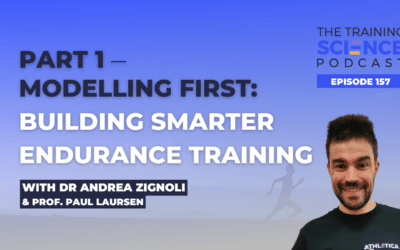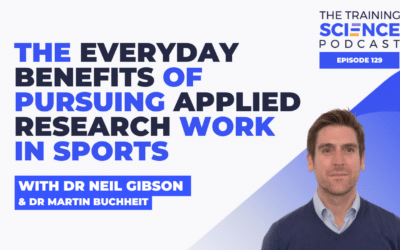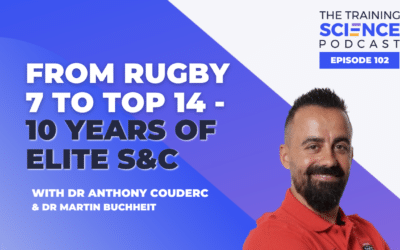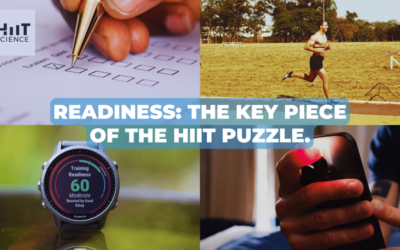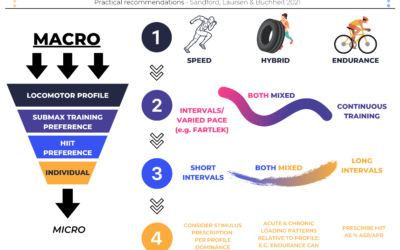Get Your Monthly Knowledge HIIT
The HIIT Science Blog
Stay up to date with the latest research, tips, and updates
Part 1: Modelling First: Building Smarter Endurance Training – With Dr Andrea Zignoli & Prof. Paul Laursen
Listen to the episode now or find us on Spotify and Apple Podcasts.Show Notes Prior knowledge makes every model better. While this may sound obvious, it cannot be stressed enough: feeding models with your historical training data makes the outputs far more relevant...
Eccentric Training: The Overlooked Foundation of Athletic Performance
Eccentric training is more than just a sub-method in the "strength" category of S&C. It’s foundational, yet often neglected. Think about it: at least 50% of actions in team sports are decelerations—sometimes more (Silva et al., 2023). You see this as a coach, an...
The Everyday Benefits of Pursuing Applied Research Work in Sports – With Dr Neil Gibson & Dr Martin Buchheit
Listen to the episode now or find us on Spotify and Apple Podcasts.Show Notes People in positions can utilise and harmonise each of their responsibility to MAXIMISE BENEFITS for athletes and players. This does not mean that the HEAD of something is always right, nor...
Individually-Owned Data, Research & Interdisciplinary Collaboration
Listen to the episode now or find us on Spotify and Apple Podcasts.Show Notes Academic validity vs applied validity: often, in the field, we cannot 100% be precise enough in the quality of information for academic “standards”. Yet, that does not mean that it is not...
From Rugby 7 to Top 14 – 10 YEARS of ELITE S&C – with Dr Anthony Couderc & Dr Martin Buchheit
Listen to the episode now or find us on Spotify and Apple Podcasts.Show Notes As we so often say: always DRIVE the research and your little (but IMPACTFUL!) science questions from the field. For this it is best to have “integrated” scientists, S&C and other...
The 5 NEW HIIT INSIGHTS That Could Change The Way You Train – with Dr. Rune Talsnes
Listen to the episode now or find us on Spotify and Apple Podcasts.Show Notes High or low intensity specific periodization may or may not work for different individuals. For some this may seem obvious, for others controversial. The reality is that we are learning more...
Listen to Your Body, Not Your Heart: How to Optimize Endurance Training Results with “Self-Reported Stress Tolerance”
Have you ever thought about what tools are best for telling us when to apply HIIT the next time? How do we know when we will handle it again without driving our athlete into overtraining or injury risk? If you’ve read our book or taken our course, you’ll know about how important this variable will be when we look to design the ideal program. Both heart rate variability and subjective comments were key factors we discussed. But is one better than the other?
Maybe. We’ve stumbled upon an incredible study that might just help clear our thoughts on the matter in terms of athlete readiness and when to apply HIIT again in the future to maximize performance potential. The blog post written by Diego Hilgemberg Figueiredo compares training plans guided by either HRV or subjective inner feelings. The findings may surprise you. Check out a sneak peak in the graphic below as to why heart rate and HRV can’t always bring us certainty around readiness to perform. They’re good, and helpful, but you must know your context! Combine it with feel to get the most power in your programming.
“In Search of the Perfect Workout: Does Decreasing High-Intensity Interval Duration Hold the Answer?”
Every coin has two sides - what is recovering in HIIT? VO2max is defined as the highest rate at which oxygen can be absorbed and utilized by the body during severe exercise (Hill and Lupton 1923). It represents one of the most important parameters for the assessment...
Medical, Science & Hands-on Staff All Matter Now More Than Ever – With Dr Ian Beasley
Listen to the episode now or find us on Spotify and Apple Podcasts.Show Notes Medical staff is all encompassing health - it is slightly different then “just” performance. Remember that your medical and health staff have to always put the health of these humans first....
Performance into the Ages: what can we learn from world-class masters athletes?
Aging is associated with lowered performance across most sports that include a heavy physical component, including running. Yet, an increasing number of elderly individuals engaged in running are interested in optimizing their performance. What does the science...
World Cup 2022 – Running Analysis For Group Stage
Qatar 2022 Football World Cup Running Analysis: Group Stages Part 1 In this short blog, we summarize the highest physical performers across the group stages of the 2022 Qatar Football World Cup. Although we understand the limitation of such “cherry-picked” data, we...
Applying the Anaerobic Speed / Power Reserve in Practice
Intro and recap of key terminology. Many individual and team sport events require extended periods of exercise above the speed or power associated with maximal oxygen uptake (i.e., maximal aerobic speed/power, MAS/MAP). In the absence of valid and reliable measures of...

